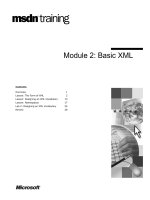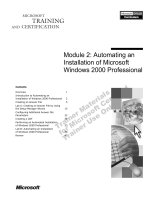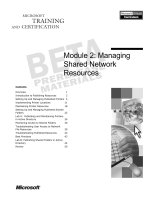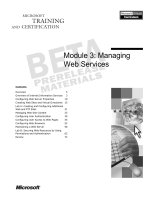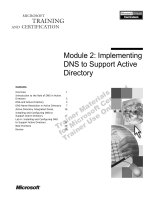Tài liệu Module 2: Examining Web Storage System Schema doc
Bạn đang xem bản rút gọn của tài liệu. Xem và tải ngay bản đầy đủ của tài liệu tại đây (429.78 KB, 34 trang )
Contents
Overview 1
Schema Function 2
Schema Structure 3
Creating a Custom Schema 11
Lab A: Extending the Web Storage
System Schema 19
Review 25
Module 2: Examining
Web Storage System
Schema
Information in this document is subject to change without notice. The names of companies,
products, people, characters, and/or data mentioned herein are fictitious and are in no way intended
to represent any real individual, company, product, or event, unless otherwise noted. Complying
with all applicable copyright laws is the responsibility of the user. No part of this document may
be reproduced or transmitted in any form or by any means, electronic or mechanical, for any
purpose, without the express written permission of Microsoft Corporation. If, however, your only
means of access is electronic, permission to print one copy is hereby granted.
Microsoft may have patents, patent applications, trademarks, copyrights, or other intellectual
property rights covering subject matter in this document. Except as expressly provided in any
written license agreement from Microsoft, the furnishing of this document does not give you any
license to these patents, trademarks, copyrights, or other intellectual property.
2000 Microsoft Corporation. All rights reserved.
Microsoft, Active Directory, ActiveX, FrontPage, Hotmail, JScript, MSN, Outlook, PowerPoint,
Visual Basic, Visual C++, Window Media, Visual InterDev, Visual Studio, Win32, Windows, and
Windows NT are either registered trademarks or trademarks of Microsoft Corporation in the
U.S.A. and/or other countries.
Other product and company names mentioned herein may be the trademarks of their respective
owners.
Project Lead: Samantha Smith
Instructional Designers: Sangeeta Garg (NIIT (USA) Inc.), Marilyn McCune
Instructional Software Design Engineer: William Rebozo
Subject Matter Experts: Jayme Bowers (ECMS Inc.), John Christian (ECMS Inc.),
Robert Ginsburg (ECMS Inc.), Frederick Volking (ECMS Inc
Technical Contributors: Thomas Rizzo, Brent Ingraham, Navin Kachroo, Robert Brown,
Alex Hopmann, Jim Reitz
Graphic Artist: Kirsten Larson (S&T Consulting)
Editing Manager: Lynette Skinner
Editors: Kelly Baker, Nancy Finch
Copy Editor: Ed McKillop (S&T Consulting)
Production Manager: Miracle Davis
Print Coordinator: Marlene Lambert (Online Training Solutions Inc.)
Online Production Coordinator: Jenny Boe
Test Manager: Eric R. Myers
Creative Director, Media/Sim Services: David Mahlmann
Web Development Lead: Lisa Pease
CD Build Specialist: Eric Wagoner
Localization Manager: Rick Terek
Operations Coordinator: John Williams
Manufacturing Support: Laura King; Kathy Hershey
Lead Product Manager, Release Management: Bo Galford
Program Manager, Knowledge Management: Josh Barnhill
Lead Product Manager, Knowledge Management: Janet Wilson
Group Manager, Courseware Infrastructure: David Bramble
Director, Developer Training: Juan Fernando Rivera
General Manager: Robert Stewart
Module 2: Examining Web Storage System Schema iii
Instructor Notes
This module provides students with an introduction to Microsoft
®
Web Storage
System schema and explains how the schema promotes interoperability and
reuse by using its properties, namespaces, and content classes. Creating custom
schemas is also covered. Module lecture content and learning objectives are
reinforced by a hands-on lab, Lab A, Extending the Web Storage System
Schema.
After completing this module, students will be able to:
!
Describe how schema properties, namespaces, and content classes function
to define Web Storage System schema.
!
Create a custom schema.
Materials and Preparation
This section provides the materials and preparation tasks that you need to teach
this module.
Required Materials
To teach this module, you need the following materials:
!
Microsoft PowerPoint
®
file 2019A_02.ppt
!
Module 2, “Examining Web Storage System Schema”
!
Web Storage System Explorer tool is required for the "Using the Web
Storage System Explorer" demonstration
Preparation Tasks
To prepare for this module, you should:
!
Read all of the materials for this module.
!
Complete the lab.
!
Read the topics in the Exchange 2000 software development kit (SDK) that
discuss Web Storage System schema.
Presentation:
45 Minutes
Lab:
20 Minutes
iv Module 2: Examining Web Storage System Schema
Discussion
This section provides discussion notes that will not fit in the margin notes or are
not appropriate for the student notes.
Discussion: Default Properties and Namespaces
The objective of this instructor-led group discussion is to introduce the students
to some of the more common default properties and namespaces that are
available in Web Storage System schema. The goal is to present how the
properties are used in different circumstances. You do not need to discuss in
detail how to implement these properties; just give an overview of property
function.
Begin by defining the properties in the "DAV:" namespace. Mention that the
values for many of the properties in the "DAV:" namespace do not have to be
set explicitly because they are automatically assigned values by the Web
Storage System. Discuss how the properties of the "DAV:" namespace are
defined by Internet standards organizations to promote interoperability between
applications and platforms.
Define the " namespace as a set of
properties implemented by Microsoft Exchange 2000 Server. Note that these
properties can have predefined programming enumerations associated with
them that you can use when you set the value. For example, the
properties can be
represented by the CdoSensitivityValues Collaboration Data Objects (CDO)
enumeration.
Ask for an example of a registered domain name used by a student’s company,
and create some examples of property names such as
http://schemas/domainname/propertyname.
When discussing the "urn:schemas:calendar", "urn:schemas:contacts",
"urn:schemas:httpmail", and "urn:schemas:mailheader" namespaces, discuss
how the properties are defined by Internet standards organizations.
Discuss the difference between the "urn:schemas:httpmail" and the
"urn:schemas:mailheader" namespaces. The properties for the
“urn:schemas:httpmail” namespace are expressed as Unicode characters and the
properties for the “urn:schemas:mailheader” namespace are expressed as ASCII
characters.
When discussing the " and
"urn:schemas-microsoft-com:office:forms" namespaces, define event
registrations and Web form registrations. Explain how to use these properties to
create a decision table. Mention that you will be going into greater detail about
how to use the properties in these namespaces in later sections.
When discussing the "urn:schemas-microsoft-com:xml-data", "urn:schemas-
microsoft-com:datatypes" and "urn:schemas-microsoft-com:exch-data"
namespaces, explain how to use them to create custom properties. Mention that
you will be going into greater detail about how to use the properties in these
namespaces in later sections.
Module 2: Examining Web Storage System Schema v
When discussing the "
namespace, explain how it uses Extensible Markup Language (XML) to
establish role-based security on an item or folder level. (Read the article at
/default.asp?URL=/library/techart/secroles.htm)
vi Module 2: Examining Web Storage System Schema
Demonstration
This section provides demonstration procedures that will not fit in the margin
notes or are not appropriate for the student notes.
Demonstration: Using the Web Storage System Explorer
!
Prepare for the demonstration by completing the following steps:
1. Start Exchange System Manager. Create a new public folder in the Public
Folders tree and name it ExpenseReport.
2. Create another public folder in the Public Folders tree and name it
ExpenseReportSchema.
3. Open the Web Storage System Explorer tool
4. Type the username, password, and the URL of the ExpenseReportSchema
folder as http://localhost/public/expensereportschema.
5. Select the baseschema property and set it equal to the
non_ipm_subtree/schema location. For example, set it to
http://localhost/public/non_ipm_subtree/schema/
6. Create a new property definition, and give it a unique name using a
namespace, such as http://schemas/domainname/expensereport/state.
Save the property definition as State.
7. Set the data type to String and specify that the property is indexed.
8. Create a new content class and give it a unique name using a namespace
such as http://schemas/domainname/expensereport/. Save the content
class as Expensereport.
9. Using the Web Storage System Explorer, specify that your new content
class extends the urn:content-classes:item content class.
10. Add the custom property you created, http://schemas/domainname
/expensereport/state/, to the content class, and then save your changes.
11. Using the Web Storage System Explorer, open the ExpenseReport folder
that you created earlier.
12. Set the schema-collection-ref property equal to the URL of the schema
folder you created earlier, http://localhost/public/ExpenseReportSchema.
13. Explain the results of what you just did. You created a schema folder and set
its baseschema property to the non_ipm_subtree/schema directory so that
you can use all the existing properties of the Web Storage System. You
created a new property and used a namespace to differentiate it from other
properties. You created a custom content class that extends the
urn:content-classes:item content class and uses the custom property that
you created earlier.
Module 2: Examining Web Storage System Schema vii
Module Strategy
Use the following strategy to present this module:
!
Schema Function
Define the terms schema, and schema-aware application.
Present Web Storage System schema as a flexible operating environment for
storing, sorting, searching, and indexing resources.
!
Schema Structure
Describe how properties and namespaces function in the Web Storage
System and emphasize that each collection of properties defines a
namespace. List the set of default namespaces used by the Web Storage
System to define resources.
Present the function of content class. Explain how to read and set the
content class of a resource by using the DAV:contentclass schema
property. List the predefined content classes provided by Exchange 2000.
Use the example of an expensereport content class to explain how to
extend a schema.
!
Creating a Custom Schema
Use the example of an expense report to explain how to create a custom
schema by appending a property and how to create a custom content class.
Define schema scope. Present the two folder properties that are used to
configure folder schema scope.
Describe the procedures for creating a schema, property definitions, and
content class definitions.
Module 2: Examining Web Storage System Schema 1
Overview
!
Schema Function
!
Schema Structure
!
Creating a Custom Schema
Microsoft
®
Web Storage System schema provides a flexible operating
environment for storing, sorting, searching, and indexing resources in the Web
Storage System.
After completing this module, you will be able to:
!
Describe the function of schema.
!
Describe how properties, namespaces, and content classes function to define
Web Storage System schema.
!
Create a custom schema.
Topic Objective
To provide an overview of
the module topics and
objectives.
Lead-in
The Web Storage System
schema platform allows
applications to share data.
2 Module 2: Examining Web Storage System Schema
Schema Function
Mechanism for Schema-Aware Applications to Discover the
Properties That are Used by Resources in the Web Storage System
A schema is a collection of properties that define all the resources, such as
folders, items, and Web files, found in the Web Storage System.
Schema structure is not as rigidly enforced in the Web Storage System as it is in
a relational database system, such as Microsoft SQL Server
™
. Instead, a schema
in the Web Storage System is used primarily to provide a mechanism for
schema-aware applications to interpret the properties that are used by a resource
in a particular application.
A schema-aware application is an application that can access and modify the
schema properties associated with resources to sort, query, and index resources
in the Web Storage System.
The properties that can be applied to resources in the Web Storage
System are interpreted by using multiple application programming interfaces
(APIs) and protocols, such as OLE DB, MAPI and Hypertext Transfer Protocol
(HTTP). Microsoft Outlook
®
2000 uses MAPI to communicate with resource
properties in Microsoft Exchange 2000 Server.
Topic Objective
To present the function of a
Web Storage System
schema.
Lead-in
Schemas enable schema-
aware applications to
interpret the properties of a
resource maintained by the
Web Storage System.
Note
Module 2: Examining Web Storage System Schema 3
#
##
#
Schema Structure
!
Properties and Namespaces
!
Content Classes
Properties, namespaces, and content classes define the schema for a resource
maintained by the Web Storage System. The Web Storage System uses a set of
default properties, namespaces, and content classes to define resources. You can
create custom schemas and reuse an existing schema to define a custom
application.
Topic Objective
To list the topics related to
schema structure.
Lead-in
Properties, namespaces,
and content classes define
schema.
4 Module 2: Examining Web Storage System Schema
Properties and Namespaces
http//schemas/microsoft.com/exchange
Namespace
/> /> />urn:schemas:httpmail Namespace
urn:schemas:httpmail:from
urn:schemas:httpmail:to
urn:schemas:httpmail:subject
urn:schemas:httpmail:hasattachment
urn:schemas:httpmail:calendar
urn:schemas:httpmail:displaybcc
urn:schemas:mailheader Namespace
urn:schemas:mailheader:from
urn:schemas:mailheader:content-description
urn:schemas:mailheader:content-language
urn:schemas:mailheader:mime-version
Web Storage System schema namespaces consist of grouped properties.
Properties
By default, the Web Storage System contains a variety of properties that
describe messages, contacts, appointments, documents, and other resources
stored in the Web Storage System. You can use these properties to efficiently
organize, index, sort, view, and search resources. In addition, you can use the
Web Storage System to create custom properties.
Namespaces
A namespace is the unique name that is used as a prefix to the name of each
property in the group.
Grouping Properties into Namespaces
The illustration in the slide shows urn:schemas:httpmail:subject as the full
property name used to define the subject of a message. The property belongs to
the "urn:schemas:httpmail" namespace, which contains other properties that are
used to define messages. The "urn:schemas:httpmail" namespace also includes
properties that define the recipient and sender of a message
(urn:schemas:httpmail:to and urn:schemas:httpmail:from) and a property
that indicates whether a message has an attachment
(urn:schemas:httpmail:hasattachment).
Use namespaces to uniquely identify properties that have the same name. For
example, you can use a State property to refer to a country or to refer to the
state of a document in a process. To differentiate between the two uses, you can
prefix each State property with a unique namespace.
Determining the Namespace Prefix
The prefix to the namespace indicates whether the namespace is specific to a
particular product or in agreement with Internet standards.
Slide Topic
To illustrate how a
namespace contains a
group of properties.
Lead-in
In the Web Storage System,
schema properties that
define similar resources are
grouped into namespaces.
Module 2: Examining Web Storage System Schema 5
""
Namespaces that begin with the string "" are
defined specifically for use with Microsoft products. For example, the
namespace " /exchange" is for Exchange 2000 and
consists of fields optimized for that product. You can use properties in this
namespace when building applications for use with Exchange 2000.
"urn:schemas"
Namespaces that begin with the string "urn:schemas" are defined by one of
various Internet standards; these are registered namespaces and are generic
enough to be applied to multiple products. For example, the
"urn:schemas:calendar" namespace, contains properties that are defined for
Internet-based scheduling and can be used by multiple tools and operating
systems. You can use properties from this namespace to build generic
scheduling solutions for use by any type of client.



